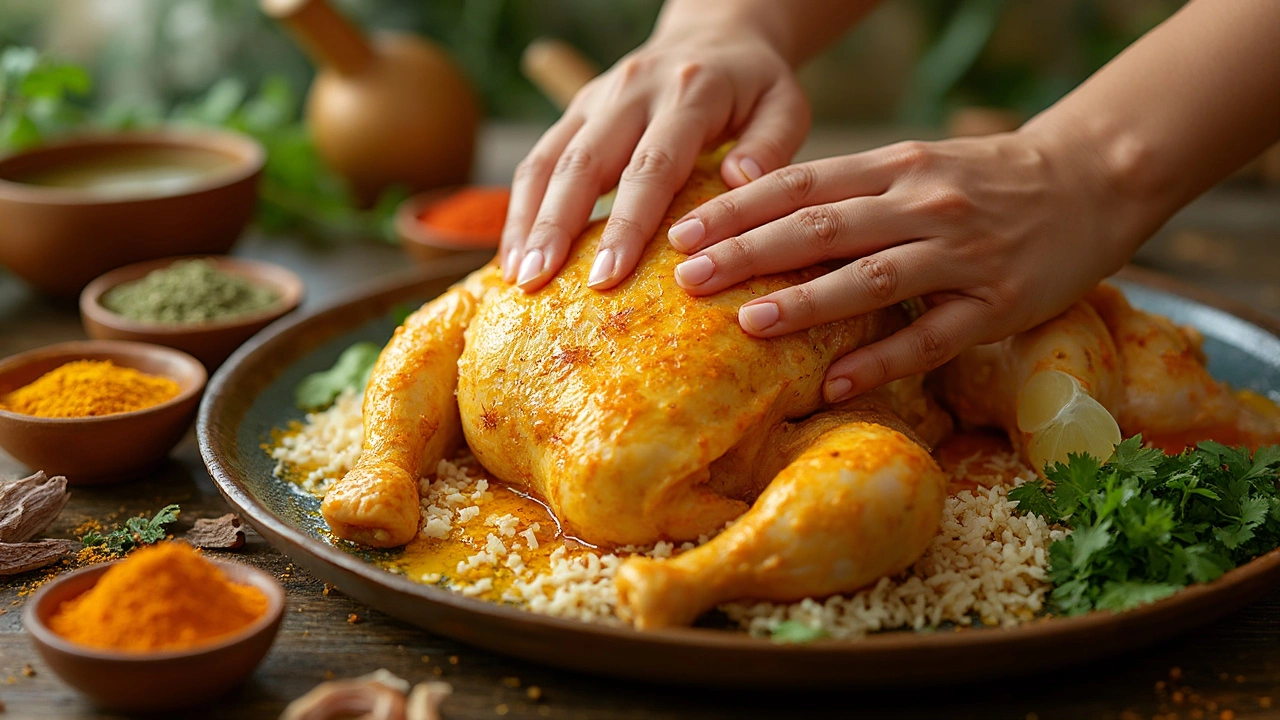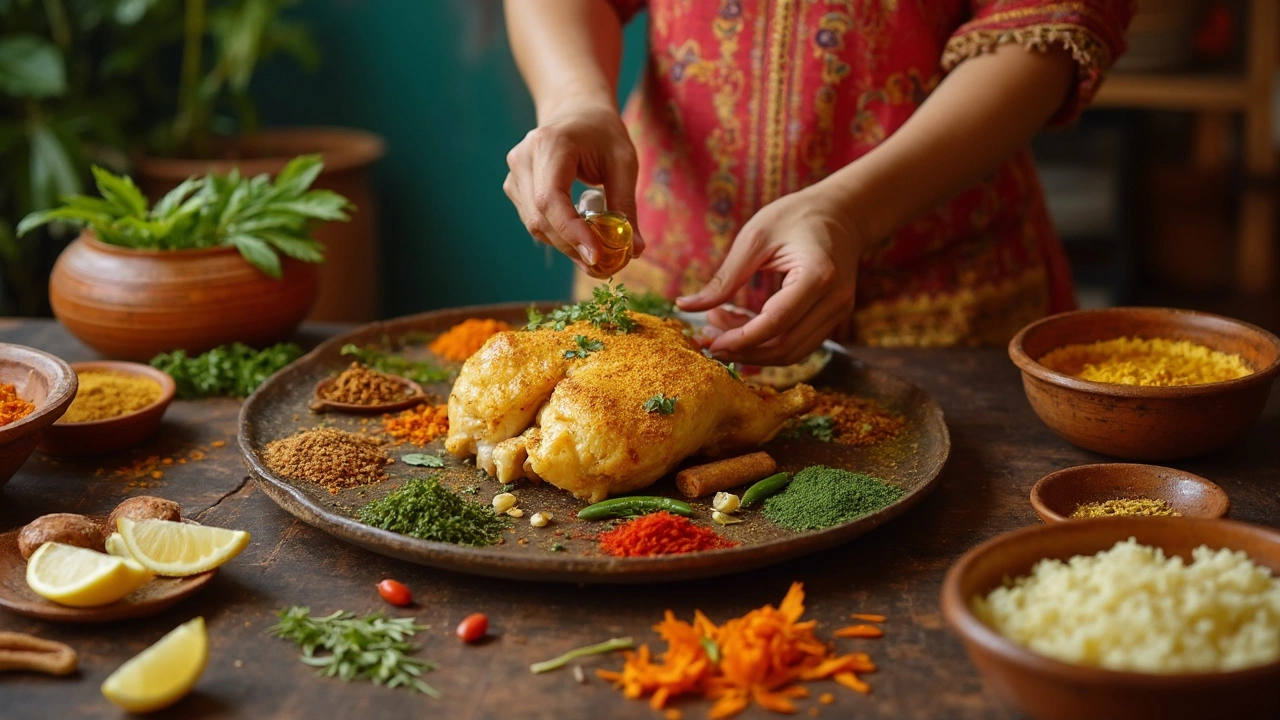Stuck without yogurt but still craving that classic tandoori chicken flavor? You're not alone. So many people hit the fridge and realize the yogurt's all gone, or maybe dairy just isn't your thing. Good news: you don't have to give up on tandoori chicken. There's a whole toolbox of ingredients you can use instead, and—surprise—they might even be in your kitchen right now.
The main job of the yogurt in tandoori marinade is to tenderize the chicken and help those spices stick. But get this—it's more about the acidity and moisture than the yogurt itself. If you swap in something else that's a little tangy or has a bit of acid, you can get a very similar result. Think lemon juice, vinegar, or even buttermilk for folks who can handle a bit of dairy but not full-on yogurt.
- Why Yogurt Is Used in Tandoori Marinades
- What Actually Happens When You Skip Yogurt
- Alternative Marinade Bases That Work
- How To Marinate for Best Flavor and Texture
- Real-Life Tips for Tasty Tandoori Without Yogurt
Why Yogurt Is Used in Tandoori Marinades
Yogurt is basically the backbone of traditional tandoori chicken marinades. If you're wondering what makes that chicken so juicy and tender, here’s the secret: it’s all about what yogurt does to the meat. The live cultures and mild acids in yogurt gently break down the protein fibers—kind of like giving the chicken a quick ‘spa day’ before it hits the grill. This makes the meat soft but not mushy, which is exactly what everyone wants with tandoori.
Besides tenderizing, yogurt also helps the marinade stick better. Spices and aromatics like garlic, ginger, and chili powder just cling on to the thick yogurt base. That way, you get a burst of flavor in every bite—not just on the surface.
Take a look at how yogurt stacks up versus other common marinade bases:
| Marinade Base | Tenderizing Power | Helps Spices Stick? | Common In Tandoori? |
|---|---|---|---|
| Yogurt | High | Yes | Yes |
| Lemon Juice | Medium | No | Sometimes |
| Vinegar | Medium | No | Rarely |
| Buttermilk | High | Yes | Sometimes |
There’s a little science behind it, too. Researchers found that marinades with lactic acid (like yogurt and buttermilk) tenderize chicken up to 40% more than plain acidic marinades, while keeping moisture locked in. No wonder most tandoori chicken recipes stick to yogurt as the main player!
What Actually Happens When You Skip Yogurt
So, what really goes on if you leave yogurt out of your tandoori chicken marinade? Honestly, you won't totally ruin the dish, but you will notice some key changes—mostly in texture and how the flavors get into the meat. Yogurt does double-duty: it breaks down some of those tougher muscle fibers, and it grabs onto the spices so they soak right in. Without it, you have to get creative to avoid ending up with dry, bland chicken.
The acid found in yogurt is what helps soften up the chicken. Skip it, and you’ll still get color and flavor on the outside, but the inside might not be as juicy or tasty. You’ll see a bigger difference if you’re using big chunks of meat or bone-in chicken because those need more help getting seasoned all the way through.
Let’s break it down so you can really see what changes when you go yogurt-free:
- Texture: Expect the chicken to be a bit firmer. Yogurt helps tenderize, so without it, keep an eye on your marinating time.
- Flavor absorption: Marinades without yogurt sometimes don’t cling as well or soak in as deeply. You’ll want extra acidity from another source if you still want bold, punchy flavor.
- Surface color: The typical tandoori look comes partly from yogurt reacting with spices. Without it, your chicken could be a little less vibrant.
To give you a clearer idea, here’s a quick cheat sheet on what to expect when you kick yogurt out of your marinate chicken plan:
| With Yogurt | Without Yogurt |
|---|---|
| Very tender and juicy | Slightly firmer texture |
| Spices soak in deeply | Flavors mostly on surface |
| Classic reddish-orange color | Paler, sometimes less even coloring |
| Milder tang | More dependent on marinade acid |
The workaround is simple: make sure you swap in something else with a bit of acid (like lemon, lime, or vinegar) and maybe extend your marination time to get the most out of your spices. You’re still totally on track for awesome tandoori chicken, yogurt or not.

Alternative Marinade Bases That Work
You don’t have to stick with yogurt to whip up tasty tandoori chicken. A lot of folks are surprised to find how many swaps actually work—I’m talking about stuff you probably already have. The key? Go for something tangy and slightly acidic to help break down the chicken and let flavors soak in. Here are the big hitters:
- Buttermilk: Super common in southern fried chicken and works just as well here. It stays mild but packs enough acidity to keep your chicken juicy.
- Lemon juice or lime juice: Tons of tang, and you can use it solo or mixed with a bit of oil and your spice mix. Just don’t overdo the citrus—too much can make the meat mushy.
- Vinegar (white, apple cider, or rice vinegar): A splash in your marinade gives you that sharpness yogurt brings. Try mixing one tablespoon of vinegar with every cup of water or oil.
- Coconut milk: A go-to for folks avoiding all dairy. It brings a subtle sweetness and helps keep things moist.
- Sour cream or crème fraîche: Higher in fat, but the creamy texture can mimic yogurt. Go easy with these or mix with a splash of lemon to thin things out.
So, how do these options measure up? Here’s a quick look:
| Marinade Base | Acidity (pH) | Dairy-Free | Flavor Impact |
|---|---|---|---|
| Yogurt | ~4.5 | No | Tangy, Creamy |
| Buttermilk | ~4.5-5.0 | No | Mild Tang |
| Lemon Juice | ~2.0 | Yes | Bright, Zesty |
| Vinegar | ~2.4-3.4 | Yes | Sharp, Clean |
| Coconut Milk | ~6.0-7.0 | Yes | Sweet, Mild |
| Sour Cream | ~4.5 | No | Rich, Creamy |
The most important thing is balance—don’t go nuts with anything too acidic or you’ll end up with chicken that’s weirdly soft or almost “cooked” before it hits the oven or grill. Start simple and adjust by taste. And always use your go-to marinate chicken spices: garam masala, cumin, coriander, chili powder, garlic, ginger, and salt. No fancy yogurt? No problem.
How To Marinate for Best Flavor and Texture
If you skip yogurt, getting juicy, flavorful chicken is all about how you marinate. Pay attention to your acid, spices, and marinating time, and you're already ahead of the game. Here’s what really matters:
- Acid Base: Use something acidic to help break down the chicken fibers. Lemon juice, lime juice, apple cider vinegar, white vinegar, or buttermilk (if you tolerate a bit of dairy) all do the trick. Usually, about 2-3 tablespoons for every pound of chicken works well.
- Oil: Add a couple of tablespoons of a neutral oil (canola or vegetable) to help the marinade stick and add moisture to the finished chicken. Olive oil gives a distinct flavor—add it only if that’s what you want.
- Spices: The heart of any tandoori chicken marinade is its spice mix. Go for ground cumin, coriander, smoked paprika, garam masala, turmeric, chili powder, and a little salt. Fresh garlic and ginger are game changers—grate them right into the marinade for a flavor boost.
Now, here’s the thing: marinating time matters. If you’re using a strong acid like lemon juice or vinegar alone, don’t go overboard—2 to 4 hours is usually enough. Too long and you end up with mushy meat. If your acid is less aggressive, like buttermilk, you can stretch it up to 8 hours or even overnight.
| Marinade Acid | Recommended Time | Effect on Chicken |
|---|---|---|
| Lemon Juice / Vinegar | 2-4 hours | Fast tenderizing, bold flavor |
| Buttermilk | Up to 8 hours | Gentler, keeps chicken moist |
| Yogurt (if used) | 6-12 hours | Mild, classic flavor |
Last step: don’t forget to poke holes or make shallow cuts in the chicken before you coat it in marinade. This lets the flavors get deep inside. And always cover the chicken and refrigerate it while it’s marinating—this keeps it safe and juicy. Right before cooking, shake off excess marinade so it doesn’t burn in the oven or on the grill.
If you get this right, you’ll have chicken that’s full of flavor, spicy, slightly charred on the edges, and super tender without needing any yogurt at all.

Real-Life Tips for Tasty Tandoori Without Yogurt
You want that tandoori chicken flavor—smoky, spicy, and juicy—just without the yogurt. Here’s what works in real kitchens, not just in theory. Actual results, no guesswork.
First, try marinating with lemon juice, apple cider vinegar, or even tomato purée. Each of these adds that bit of tang you need and helps break down the chicken fibers, so it stays tender. Add a splash of oil—like neutral canola or even a bit of mustard oil if you want extra traditional flavor. If you’re skipping yogurt for allergy reasons or going dairy-free, coconut milk can be a star swap. It brings creaminess and keeps the spices glued to your chicken.
Check out this simple marinade formula you can riff on:
- 1-2 tablespoons lemon juice or vinegar
- 2 tablespoons coconut milk, cashew cream, or just plain water if you’re out of everything else
- 2 tablespoons oil
- 2 tablespoons tandoori masala or a mix of ground cumin, coriander, paprika, turmeric, cayenne, salt
- Optional: 1 tablespoon tomato paste for a bit of body
Mix everything in a bowl, toss in your chicken, and make sure every piece is coated. Pop it in the fridge and let it chill for at least two hours—overnight is best for flavor.
Here’s a table showing marinade times and their impact on tenderness and flavor:
| Marinade Time | Tenderness | Flavor Intensity |
|---|---|---|
| 30 minutes | Light | Mild |
| 2 hours | Medium | Good |
| Overnight | Very Tender | Bold |
Don’t forget to crank your oven or grill up hot—like 220°C (425°F) or even higher. That heat’s what nails the char and smoky flavor, especially if you can add a little wood smoke or throw in a bit of smoked paprika.
This tip’s super simple but always works: if your marinade seems runny, add a spoonful of chickpea flour (besan) or cornstarch. It will help the spices cling, especially when you’re skipping thick yogurt.
“Acidic ingredients in a marinade—like lemon or vinegar—help both flavor and tenderize chicken, especially when dairy isn’t an option,” says chef and food scientist Nik Sharma (Serious Eats, 2023).
If you want the reddish color without food dye, throw in a pinch of beetroot powder or a little extra paprika. It’s not just for looks; those spices bring some earthy heat too.
Remember, when folks search for how to marinate chicken without yogurt, they're not looking for boring grilled meat—they want the full tandoori experience. You can absolutely get that, no dairy required.
